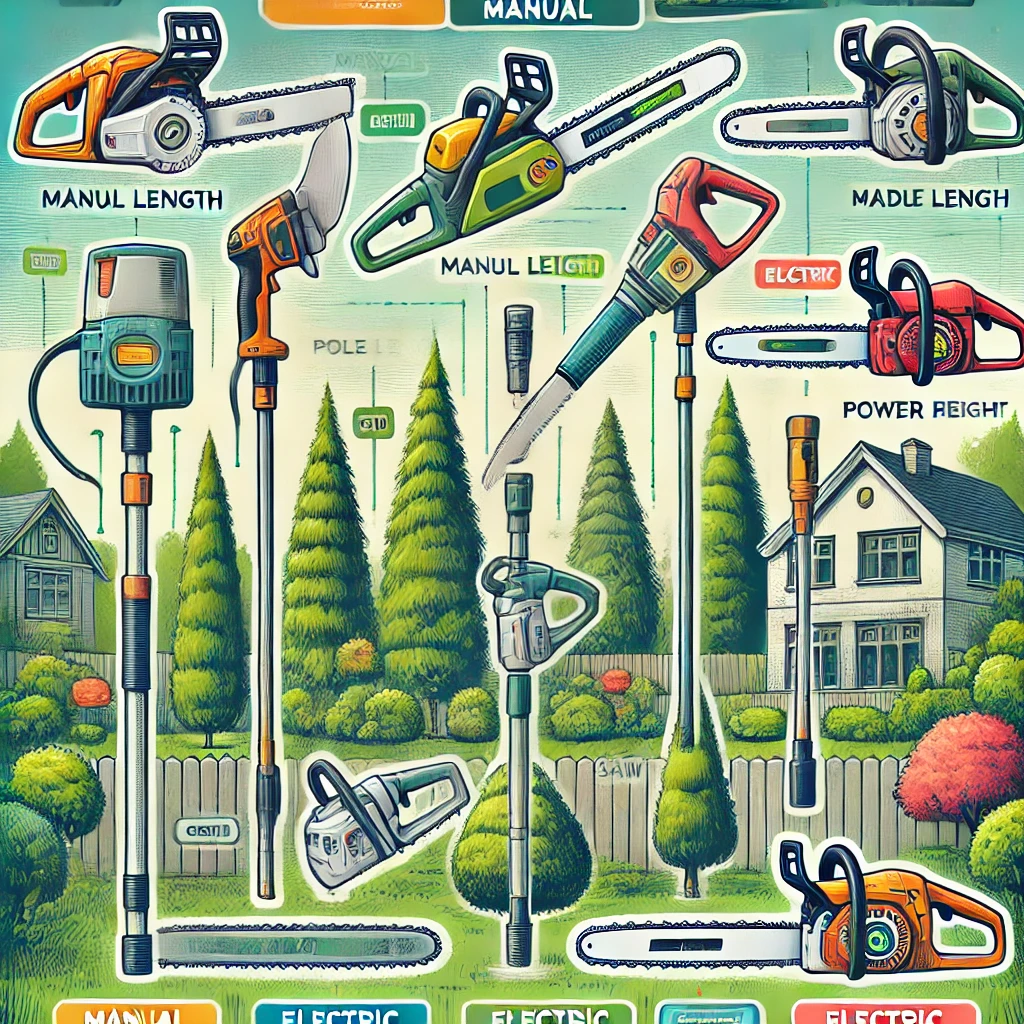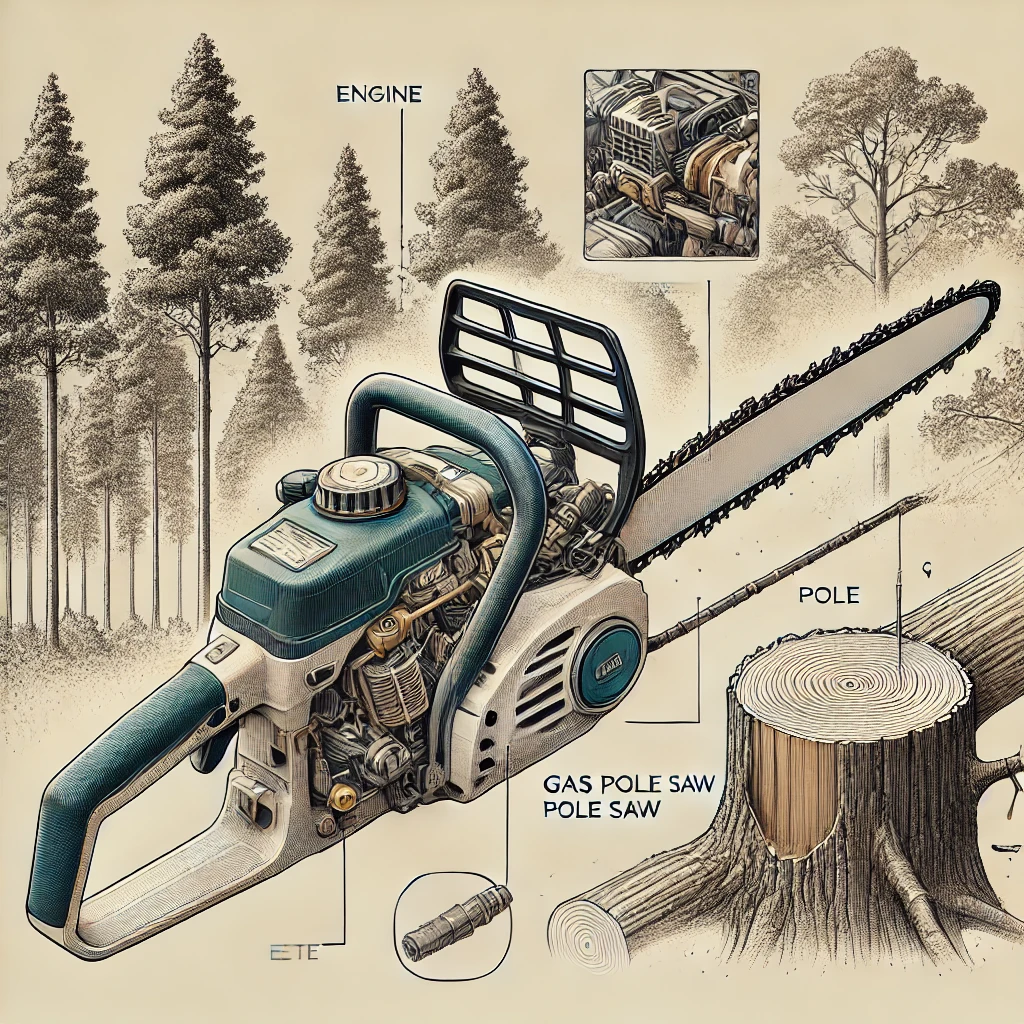When it comes to professional tree maintenance, having the right tools is essential. Among the most crucial tools for arborists and landscapers is the Industrial Pole Saw. These powerful tools allow professionals to trim branches, prune trees, and manage foliage with ease, all while staying safely on the ground. But with so many options available, it can be challenging to determine which pole saw is best suited for your specific needs.
In this guide, we will review some of the best Industrial Pole Saw on the market today, providing you with everything you need to make an informed decision. From power and durability to comfort and ease of use, we’ll cover all the essential factors to consider when selecting a pole saw for professional tree maintenance.
Table of Contents
What Is an Industrial Pole Saw?
An industrial pole saw is a long-reach cutting tool designed for trimming tree branches without the need for ladders or scaffolding. These saws are typically powered by gas, electricity, or battery and come with extendable poles that allow users to reach high branches safely. They are indispensable for tree care professionals, landscapers, and arborists who need to maintain trees on a regular basis.
Key Features to Look for in an Pole Saw
Before we dive into our top picks, it’s essential to understand the features that make an pole saw effective for professional tree maintenance:
- Power Source: Industrial pole saws come in three primary power types—gas-powered, electric (corded), and battery-operated. Gas-powered models are ideal for heavy-duty tasks, while electric and battery-powered models are quieter and more environmentally friendly.
- Pole Length: The length of the pole plays a significant role in how high you can reach. Professional-grade models often feature extendable poles that can reach up to 15 feet or more, ensuring you can access branches in the highest trees.
- Weight and Balance: Since professionals use pole saws for extended periods, weight and balance are crucial factors. A well-balanced saw reduces fatigue and increases precision, allowing you to work longer without discomfort.
- Bar and Chain: The quality of the bar and chain determines the efficiency of the cut. Look for a Industrial Pole Saw with a durable bar and chain designed for cutting through tough wood, providing clean, efficient cuts every time.
- Safety Features: Ensure the pole saw is equipped with safety features like an automatic chain brake, hand guard, and an anti-vibration system for a more secure and comfortable operation.
Pros
Cons
Top 5 Best Industrial Pole Saws for Professional Tree Maintenance
1. Stihl HT 133 Telescoping Pole Saw
Stihl is a trusted brand in the tree care industry, and the HT 133 pole saw does not disappoint. Powered by a 36.3 cc gas engine, this pole saw offers excellent cutting power and is perfect for professional arborists. The pole extends up to 12 feet, and its low-emission engine ensures you can work for extended periods without compromising environmental standards.
Key Features:
- 12-foot extendable pole
- High-efficiency 36.3 cc engine
- Anti-vibration system for smoother handling
- Easy-to-use controls
2. Echo PPT-2620 Telescoping Pole Saw
Echo’s PPT-2620 is a lightweight and durable gas-powered pole saw. With an impressive 12.2-foot reach, it is perfect for trimming medium to large trees. Its ergonomic design and well-balanced weight distribution make it easy to handle for long hours, while the powerful engine ensures fast and efficient cutting.
Key Features:
- 12.2-foot pole length
- 25.4 cc gas engine
- Anti-vibration system
- Tool-less chain tensioning for easy maintenance
3. Greenworks 40V Cordless Pole Saw
If you prefer a battery-powered option, the Greenworks 40V Cordless Pole Saw is an excellent choice. Offering a 10-foot reach and powered by a 40V lithium-ion battery, this saw provides reliable performance without the noise and fumes of gas-powered models. The lightweight design and ease of use make it ideal for quick pruning tasks around your property.
Key Features:
- 10-foot extendable pole
- 40V lithium-ion battery for up to 40 minutes of runtime
- Chain lubrication system for smoother cuts
- Quiet operation, perfect for residential areas
4. Makita XNU02Z Cordless Pole Saw
Makita’s XNU02Z cordless pole saw is designed for professionals who need a versatile and portable solution for tree maintenance. With a 10-foot extendable pole and a 18V LXT lithium-ion battery, this saw provides both power and convenience for trimming trees and bushes. The low noise and vibration make it an ideal choice for sensitive environments.
Key Features:
- 10-foot pole length
- 18V LXT lithium-ion battery (sold separately)
- Compact design for easy maneuverability
- Durable, weather-resistant construction
5. Husqvarna 525PT5S Professional Pole Saw
The Husqvarna 525PT5S is a powerful gas-powered Industrial Pole Saw designed for heavy-duty professional use. It features a 25.4 cc engine and a 12-foot extendable pole that makes it perfect for large tree maintenance. Its ergonomic design reduces strain during use, and its durable construction ensures it will last for years.
Key Features:
- 12-foot pole reach
- 25.4 cc engine for efficient power
- Ergonomic handle for comfort during extended use
- Professional-grade construction
How to Choose the Best Pole Saw for Your Needs

When selecting an pole saw for professional tree maintenance, consider the following:
- Your Specific Needs: Are you working on small residential trees or larger commercial properties? Choose a pole saw with an appropriate reach and power for your tasks.
- Ease of Use: Comfort is key for professional use. Ensure the saw is easy to control, with a lightweight design and anti-vibration features.
- Budget: High-quality pole saws come at a price, but investing in a reliable, durable model can save you time and money in the long run.
- Maintenance: Look for a model that is easy to maintain, with tool-free chain adjustments and a lubrication system that keeps the chain running smoothly.
Certainly, Shariful! Here’s an article based on the title “Hydraulic vs. Gas Pole Saw: Which One is Right for You?” with NLP keywords included, following Google’s content guidelines and written in a human-like, engaging style.
You may also like
Hydraulic vs. Gas Pole Saw: Which One is Right for You?
When it comes to pole saws, the debate between hydraulic and gas-powered models is one that many professionals face. Both types of pole saws are essential tools for tree maintenance and offer distinct advantages and disadvantages. However, choosing the right one for your needs can be challenging, especially with so many variables to consider, such as power, cost, and ease of use.
In this article, we’ll compare hydraulic and gas pole saws, exploring the key differences, benefits, and drawbacks of each to help you determine which one is right for you.
What Is a Hydraulic Pole Saw?
A hydraulic pole saw is powered by hydraulic systems, typically attached to a larger machine such as a skid steer, tractor, or excavator. These systems provide immense power, making hydraulic pole saws ideal for heavy-duty tasks. They are often used in large-scale commercial tree maintenance or forestry operations.
Key Features of Hydraulic Pole Saws:
- Powerful Performance: Hydraulic pole saws deliver superior power, making them suitable for cutting through thick, tough branches.
- Durability: Built to last and withstand demanding professional environments, hydraulic pole saws are highly durable.
- Cost and Maintenance: These saws tend to be more expensive due to their specialized nature. They also require more maintenance since they rely on complex hydraulic systems.
- Heavy Duty Applications: Best for large-scale tree trimming and forestry work.
What Is a Gas Pole Saw?

A gas pole saw is powered by a gas engine, which provides mobility and flexibility for tree maintenance. Unlike hydraulic models, gas-powered pole saws are more portable and are commonly used by landscapers, arborists, and homeowners for routine tree trimming.
Key Features of Gas Pole Saws:
- Portability: Gas pole saws are lightweight, making them ideal for mobility and use in various locations without needing to connect to an external power source.
- Powerful Cutting Ability: Gas-powered saws deliver excellent cutting performance, particularly for medium to heavy-duty tasks.
- Fuel Cost and Maintenance: These models require gas and oil, which means there are costs for fuel. Additionally, regular maintenance is needed to keep the engine running smoothly.
- Best for Smaller to Medium Jobs: Gas pole saws are great for trimming trees in residential areas, landscaping, and light commercial work.
Hydraulic vs. Gas Pole Saw: A Side-by-Side Comparison
| Feature | Hydraulic Pole Saw | Gas Pole Saw |
| Power Source | Hydraulic system from a machine | Gas-powered engine |
| Power | Very high, suitable for heavy-duty work | High, good for medium-duty tasks |
| Portability | Not portable, attached to equipment | Highly portable, can be used anywhere |
| Cost | Expensive to purchase and maintain | More affordable, with lower maintenance costs |
| Maintenance | Requires hydraulic system maintenance | Regular engine maintenance needed |
| Best Use | Large-scale commercial work, forestry | Residential or light commercial tasks |
| Weight | Heavier, requires larger machines | Lightweight and easy to maneuver |
| Efficiency | Extremely efficient for tough jobs | Efficient for smaller to medium tasks |
| Noise Level | Can be quieter depending on machinery | Noisy due to gas engine operation |
Pros and Cons of Hydraulic Pole Saws
Pros:
- High Power: Hydraulic pole saws are capable of cutting through even the thickest branches with ease.
- Durability: These saws are built to last and can withstand heavy, continuous use in commercial settings.
- Less Vibration: Hydraulic systems can minimize vibration, offering a smoother and more comfortable cutting experience.
Cons:
- Cost: Hydraulic pole saws are often much more expensive than gas-powered models, both in terms of initial purchase price and maintenance.
- Limited Mobility: Since hydraulic pole saws require a larger machine to operate, they are not as portable or flexible as gas-powered models.
- Complex Maintenance: Maintaining hydraulic systems can be more complex and costly compared to gas engines.
Pros and Cons of Gas Pole Saws
Pros:
- Portability: Gas-powered pole saws are easy to transport and can be used anywhere, making them ideal for smaller jobs and residential use.
- Cost-Effective: Gas models are generally more affordable and have lower initial costs compared to hydraulic models.
- Ease of Use: Gas-powered pole saws are simple to operate and do not require an external power source.
Cons:
- Noise: Gas engines tend to be noisier than hydraulic models, which can be a consideration if you’re working in residential areas or noise-sensitive environments.
- Fuel Costs: You’ll need to regularly buy gas and oil, which adds to the overall cost of operation.
- Maintenance: While easier to maintain than hydraulic systems, gas engines still require regular upkeep, such as oil changes, air filter cleaning, and spark plug maintenance.
Which One Is Right for You?
Choosing between a hydraulic and gas pole saw ultimately comes down to your specific needs. Here are a few questions to help guide your decision:
- Are you working on large-scale commercial projects? If so, a hydraulic pole saw might be your best choice. Its immense power and efficiency make it ideal for tackling tough, large trees.
- Do you need a portable, easy-to-use tool for light to medium tasks? A gas pole saw is likely the better option. Its mobility, combined with a good balance of power and affordability, makes it perfect for residential and landscaping needs.
- Are you working in a noise-sensitive environment? If noise is a concern, hydraulic pole saws are often quieter and could be the better choice for professional use in such areas.
FAQs
Q: What is the difference between industrial and residential pole saws?
A: Industrial pole saws are more powerful, durable, and designed for extended use, while residential models are lighter and intended for occasional use.
Q: Are gas-powered pole saws better than electric ones?
A: Gas-powered saws offer more power and mobility, making them better for heavy-duty tasks, while electric models are quieter and require less maintenance.
Q: How do I maintain an pole saw?
A: Regularly clean the chain, check the oil levels, tighten the chain, and inspect for wear and tear. Follow the manufacturer’s guidelines for optimal care.
Q: Is it safe to use a pole saw near power lines?
A: No, you should never use a pole saw near power lines due to the risk of electrocution. Consult a certified arborist for such tasks.
Final Thoughts
Investing in a top-tier Industrial Pole Saw can make a significant difference in the efficiency and safety of your tree maintenance tasks. Whether you prefer gas-powered, electric, or battery-operated models, there are plenty of options available to suit your specific needs.
By selecting a saw with the right power, reach, and features, you’ll ensure that your tree trimming projects are completed with precision and ease. Remember, regular maintenance and safety practices are essential for extending the life of your equipment and keeping you safe on the job.



Leave a Reply